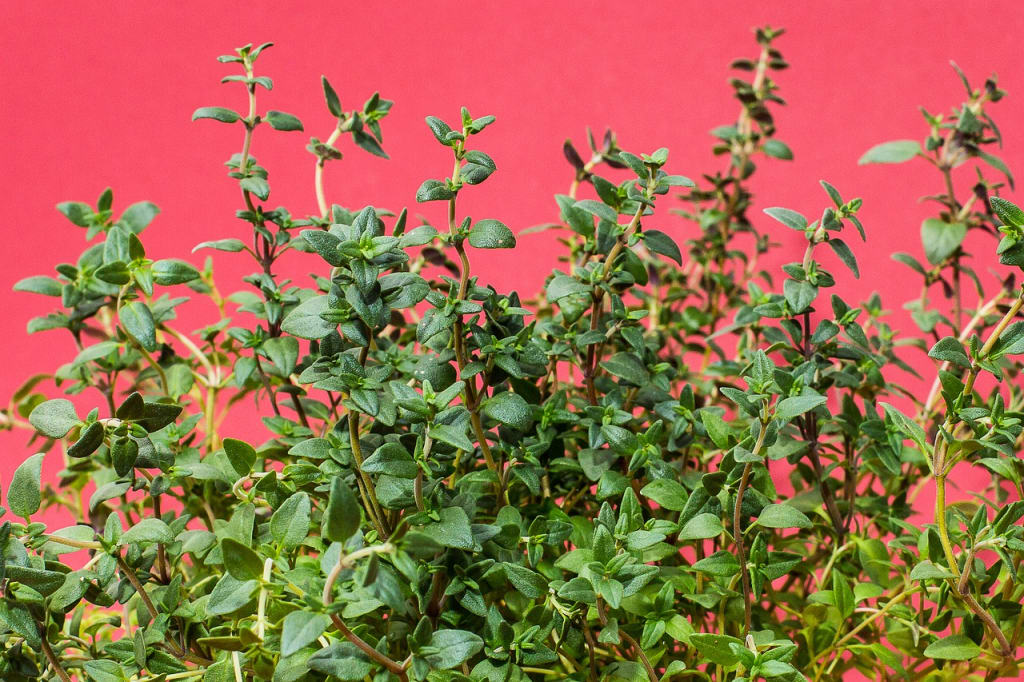Thyme for the Truth
Thyme’s Supposed Health Benefits

Disclaimer: At Ask This Guy, we believe in making educated decisions when it comes to your health. We don’t deny that plants can help treat ailments, but we do not want people to chose natural cures over medical treatments. Listen to your doctor.
My troupe of truth-seeking friends came across a Facebook post about thyme’s medicinal properties. It claims to cure vertigo, fibromyalgia, arthritis, chronic fatigue, and thyroid problems. This is quite the claim. I thought I’d look deeper and find out more about thyme and its medicinal properties.
First I thought I’d look on the internet to see what people are saying. In a Google search for “thyme medicinal,” I found the usual health benefit sites for thyme. Let's add to the benefits of Thyme. It is also good to treat bedwetting, diarrhea, stomach ache, colic, sore throat, cough (including whooping cough), bronchitis, flatulence. It is also used as a diuretic, making you pee more.
WebMD was the third link found by Google. I thought this was great. Maybe the truth isn’t lost in a Google search after all. It claims that “Thyme is taken by mouth for bronchitis, whooping cough, sore throat, colic, arthritis, upset stomach, gas, diarrhea and bed wetting…”
Wait a minute, as a diuretic, that means it makes you pee more than usual. How does that help bed wetting? Save this for later. It goes on to say it can be taken by mouth for parasitic worm infections, increased urine flow (hello dehydration), to disinfect the urine, and as an appetite stimulant.
Nowhere is the word “TREAT” used. It does not say “Taken by mouth to TREAT,” just “used for.” This means it is used, but doesn’t say it works. Pretty disappointing for WedMD. It goes on to say that the plant is applied directly to the skin for laryngitis, tonsillitis, sore mouth, and bad breath.
Then they have a How Does it Work section that says simply “Thyme contains chemicals that might help bacterial and fungal infections, and minor irritations. It also might relieve smooth muscle spasms, such as coughing.” MIGHT!?!?!?!? Since when is the medical community using might instead of treat?
My next Google search was for “thyme truth.” There must be something out there contradicting these old natural cures. Two things that pop up on the first page are for a magic spell and for VooDoo. But I also see three links to the truth about Thyme. First one, is that it's used as a disinfectant. Not much there. Le'ts add disinfectant on our list. The second link isn’t really about thyme, so thanks Google. The third has the title I’ve been looking for: “Thyme Leaves - Simple Truth.” Awesome! Someone else thinks like me!
Sorry. It sells thyme. Wow. And YouTube has similar results, which means people are being bombarded by the healing powers of thyme by several groups, including marketing and advertising, natural and organic groups.
So let's check out what we can find out about thyme in the scientific community. Believe it or not, Wikipedia is a great source for information. If you disbelieve this, I may need to write a separate article. But I will always check the references to make sure no one is fooling us.
Let's start by checking out what is in thyme that makes it medicinal. From thyme you can make an oil, in the same way that you can make mint oils. Thyme can contain 20-54 percent thymol. This is probably where many of the claims come from. So what is thymol? Well, for starters, it is a chemical. You shouldn’t be afraid of chemicals, as many are good for you. But you should be wary, as many are bad. If I say would you put the following chemicals: p-cymene, myrcene, bornrol, and linalool in your body, what would you answer right away? Chemical names are scary. We’ll see what you should have answered later.
For now, back to thymol. Thymol is an antiseptic, and an ingredient in mouthwash. Antiseptic means it kills bacteria. This is good news, because we have fact checked one of the uses on our list: disinfectant. Thymol was also used on bandages in the past before better antibiotics were found. This means that people stopped using it to treat infection because antibiotics were more effective than thymol. But, it is still used as an antiseptic, to clean and kill bacteria and fungi.
So, what can be treated with thymol from our list? If thymol is an antiseptic, it could help with conditions caused by microbes like bacteria and fungi. So it may help with diarrhea, stomach ache, colic (stomach ache for babies), sore throat, cough, whooping cough, bronchitis, and flatulence. But keep in mind that thymol was abandoned for antibiotics. Some of these ailments can be dangerous. Whooping cough and bronchitis are serious infections that should be treated by a doctor. So use along with your prescribed medications if the doctor says it’s okay. Also, if thyme is not improving a condition, seek medical attention ASAP!
The reason it is said to be effective for digestive tract problems is that thymol used to be used to treat parasites, like worms. This was more a problem in the past when sanitation was an issue. Modern day problems of the digestive tract would not be as easily treated with thyme. And there is the issue of killing good bacteria as well as bad, which can lead to the growth of superbugs.
So, if thymol makes up to 50 percent of the essential oils of the plant, what is the rest made up of? Back to my earlier question about if would you put the following chemicals in your body: p-cymene, myrcene, borneol, and linalool? These are other chemicals found in thyme. So what do they do?
P-cymene has no medicinal use that I could find. Myrcene is used in fragrances. No medical uses. These two are chemically related because they are members of the terpene family. You know terpenes as the smell of coniferous (evergreen) trees. You find these compounds in ointments that have that strong pine scent. Terpenes are also a major component in turpentine. Not exactly something you find in the medicine community.
Borneol, a terpene derivative, is an eye, skin and respiratory irritant, and is harmful if swallowed. Linalool is a terpene alcohol found in many flowers and spices. It can cause irritation, pain, and allergic reactions. When you take a natural remedy, you get a mixture of chemicals, and they are not all good for you.
So it would seem that many of its curative properties are greatly exaggerated. From the long list of helpful claims, there is nothing that shows great medicinal properties. It is an antiseptic, and that can be both good and bad. It does have a great taste, though, and should be used as spices where meant to be used—in small quantities. I wouldn’t even recommend making tea with it, as it could cause more harm than good.






Comments
There are no comments for this story
Be the first to respond and start the conversation.